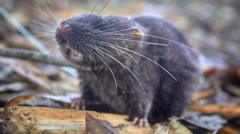In an extraordinary find, scientists have announced the discovery of 27 new species in Peru's Alto Mayo region, famous for its varied ecosystems and Indigenous territories. Among the newly identified species are an amphibious mouse, which boasts webbed feet, and a peculiar blob-headed fish, both firsts for science. The discoveries stem from an expedition conducted by the nonprofit Conservation International in collaboration with local Indigenous communities, including the Awajún people.
According to Conservation International, the finding could extend to 48 additional species pending further study. "It's remarkable to uncover such a variety of new mammals and vertebrates, especially in areas often affected by human activity," noted Trond Larsen, senior director at Conservation International.
This protected area in northern Peru faces ongoing environmental pressures from deforestation and agricultural expansion, driven by a relatively high human population density. The report not only highlights new biological findings but also empowers the Indigenous Awajún community in their efforts to safeguard their cultural heritage and natural resources, enhancing their understanding of the local ecosystem. “The Awajún have immense traditional knowledge of the flora and fauna they coexist with,” said Larsen.
Among the notable discoveries are a dwarf squirrel belonging to a new genus, eight newly identified fish species, three amphibians, and ten types of butterflies. The dwarf squirrel is particularly striking, measuring only 14cm, making it half the size of an average grey squirrel found in the UK. “It's both adorable and swift,” Larsen remarked, observing its agile movements among the tree limbs.
The blob-headed fish, identified as a type of bristlemouth armoured catfish, features an enlarged head that surprised the researchers—a trait well-known to the Indigenous collaborators who participated in the study.
In addition to these fascinating specimens, a new family of spiny mice, recognizable for their stiff guard hairs akin to hedgehog spines, was also discovered. Scientists expressed enthusiasm over the amphibious mouse, which is known to consume aquatic insects and belongs to a group of increasingly rare semi-aquatic rodents.
The expedition elucidates not only the region's biological diversity but also the significant role of community engagement in environmental conservation, as the Awajún people continue to protect their lands and knowledge for future generations.
According to Conservation International, the finding could extend to 48 additional species pending further study. "It's remarkable to uncover such a variety of new mammals and vertebrates, especially in areas often affected by human activity," noted Trond Larsen, senior director at Conservation International.
This protected area in northern Peru faces ongoing environmental pressures from deforestation and agricultural expansion, driven by a relatively high human population density. The report not only highlights new biological findings but also empowers the Indigenous Awajún community in their efforts to safeguard their cultural heritage and natural resources, enhancing their understanding of the local ecosystem. “The Awajún have immense traditional knowledge of the flora and fauna they coexist with,” said Larsen.
Among the notable discoveries are a dwarf squirrel belonging to a new genus, eight newly identified fish species, three amphibians, and ten types of butterflies. The dwarf squirrel is particularly striking, measuring only 14cm, making it half the size of an average grey squirrel found in the UK. “It's both adorable and swift,” Larsen remarked, observing its agile movements among the tree limbs.
The blob-headed fish, identified as a type of bristlemouth armoured catfish, features an enlarged head that surprised the researchers—a trait well-known to the Indigenous collaborators who participated in the study.
In addition to these fascinating specimens, a new family of spiny mice, recognizable for their stiff guard hairs akin to hedgehog spines, was also discovered. Scientists expressed enthusiasm over the amphibious mouse, which is known to consume aquatic insects and belongs to a group of increasingly rare semi-aquatic rodents.
The expedition elucidates not only the region's biological diversity but also the significant role of community engagement in environmental conservation, as the Awajún people continue to protect their lands and knowledge for future generations.


















